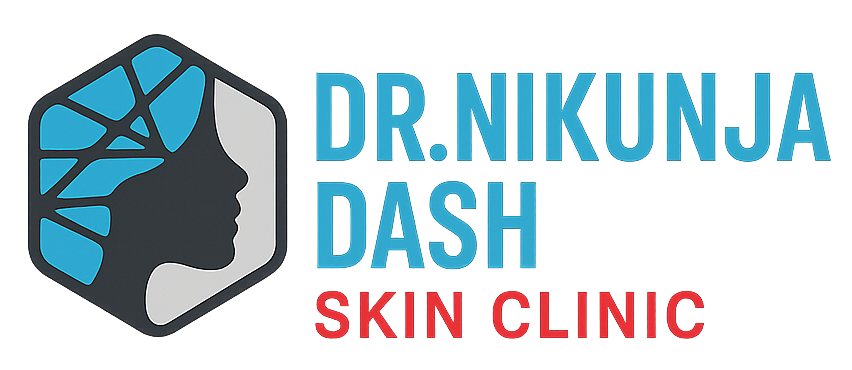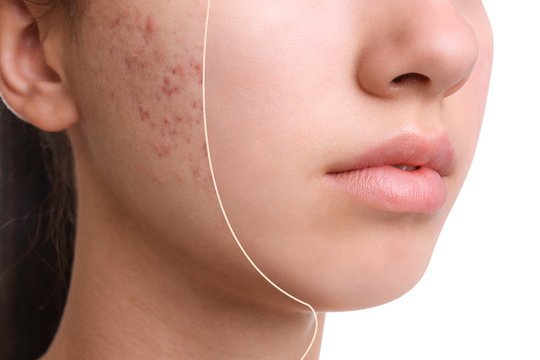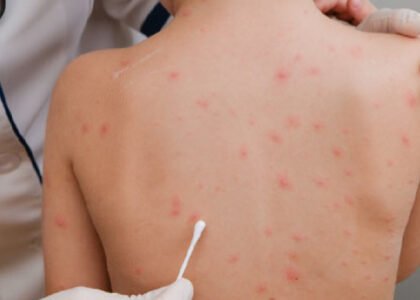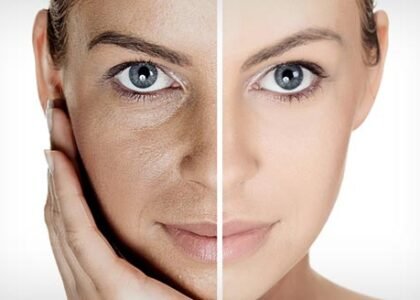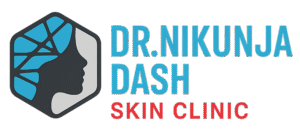Acne / Pimples Treatment
Acne / Pimples Treatment in Bhubaneswar
Acne, also known as acne vulgaris, is a chronic inflammatory skin condition that occurs when hair follicles become clogged with excess sebum (oil), dead skin cells, and sometimes bacteria. It commonly manifests as blackheads, whiteheads, papules, pustules, cysts, and nodules, primarily affecting areas rich in sebaceous (oil) glands such as the face, chest, shoulders, and back.
This condition is most prevalent during adolescence due to hormonal changes that increase oil production, but it can persist into adulthood or even appear for the first time later in life. Factors contributing to acne include hormonal fluctuations (especially androgens), genetics, stress, diet, use of oily or pore-clogging products, and environmental factors.
While acne is not life-threatening, it can significantly affect self-esteem and, if left untreated, may result in permanent scarring. Treatment options vary based on severity and include topical therapies (like benzoyl peroxide, retinoids, and antibiotics), oral medications (such as hormonal treatments or isotretinoin), chemical peels, and professional skin care procedures.
Early and effective management guided by a dermatologist can help control outbreaks, reduce scarring risk, and restore clear, healthy skin.
What is an Acne ?
Acne is a common and chronic skin condition that occurs when hair follicles become blocked with oil (sebum), dead skin cells, and sometimes bacteria, leading to various types of skin blemishes. These include blackheads, whiteheads, papules, pustules (commonly known as pimples), cysts, and nodules. Acne most commonly appears on areas of the body that have a high concentration of oil glands—such as the face, chest, shoulders, and back. It is especially prevalent during puberty due to increased hormone levels, particularly androgens, which stimulate the sebaceous glands to produce more oil. However, acne can also affect adults, particularly women, due to hormonal imbalances, stress, certain medications, and cosmetic products. While not dangerous, acne can cause emotional distress, reduce self-confidence, and may lead to long-term skin damage or scarring if not properly managed. Understanding the causes and triggers of acne is key to finding an effective treatment, which may include lifestyle changes, skincare routines, and professional medical therapies like topical creams, antibiotics, hormonal treatment, or advanced dermatological procedures.
Different Types of Acne – A Complete Guide
Acne can present in various forms, depending on how deeply the inflammation reaches the skin, how clogged the pores are, and whether or not bacteria are involved. It is generally classified into two main categories: non-inflammatory acne and inflammatory acne. Each type looks and behaves differently, requiring different treatment approaches. Below is a detailed overview of the most common acne types:
1. Non-Inflammatory Acne
These are milder forms of acne and usually do not cause pain or swelling. They form due to blocked pores but without significant inflammation.
a. Blackheads (Open Comedones)
Blackheads occur when a hair follicle or pore becomes clogged with sebum and dead skin cells. The pore remains open, and the surface of the clog oxidizes when exposed to air, turning it black. Despite common belief, the black color is not dirt but melanin reacting with oxygen. Blackheads are commonly found on the nose, chin, and forehead and are often persistent.
b. Whiteheads (Closed Comedones)
Whiteheads are similar to blackheads, but in this case, the clogged pore remains closed at the surface. This creates a small, flesh-colored or white bump on the skin. Because the follicle is closed, the trapped material is not exposed to oxygen and doesn’t darken. Whiteheads can be more difficult to treat because the blockage is under the skin.
2. Inflammatory Acne
Inflammatory acne involves red, swollen, and sometimes painful pimples. This happens when bacteria (especially Cutibacterium acnes, formerly Propionibacterium acnes) grow inside clogged pores, triggering an immune response and causing inflammation.
a. Papules
Papules are small red or pink bumps on the skin that are tender to the touch. They occur when a blocked pore becomes inflamed but doesn’t contain visible pus. Papules can cluster together and make the skin feel rough or uneven. It’s important not to squeeze them, as this can worsen inflammation or cause scarring.
b. Pustules
Pustules are inflamed lesions that look like papules but are filled with white or yellowish pus. They have a red base with a white center and resemble the classic “pimple.” Pustules are caused by a buildup of sebum, dead skin, and bacteria. Though tempting, popping them can lead to more breakouts or scarring.
c. Nodules
Nodules are large, painful lumps beneath the surface of the skin. They develop when the walls of a pore break deep within the skin, releasing infected material into surrounding tissue. This leads to a larger, firmer, and more deeply rooted lesion. Nodular acne can last for weeks or months and often requires medical treatment, as over-the-counter products are typically ineffective.
d. Cysts
Cystic acne is the most severe form. Cysts are deep, painful, pus-filled lumps that resemble boils. They form when the infection spreads deep into the skin, causing severe inflammation and swelling. Cystic acne often leads to permanent scarring if left untreated. It is common in people with a family history of severe acne and usually requires intervention by a dermatologist, including oral medications like isotretinoin.
3. Hormonal Acne
Hormonal acne is not a specific lesion type but rather a pattern of acne linked to hormonal fluctuations. It commonly affects adult women, especially around menstruation, pregnancy, menopause, or conditions like PCOS (Polycystic Ovary Syndrome). It typically appears on the lower face, jawline, and chin, and may consist of deep cysts or inflamed papules. Treatment often includes hormonal therapies like birth control pills or anti-androgens (e.g., spironolactone).
4. Acne Mechanica
This type of acne is caused by physical pressure, friction, or heat—often seen in athletes or people who wear tight clothing, helmets, or masks. It results in small bumps or inflamed pimples in areas where the skin is constantly irritated. Preventing friction and keeping the skin clean is crucial in managing acne mechanica.
5. Fungal Acne (Malassezia Folliculitis)
Although it looks like typical acne, fungal acne is caused by an overgrowth of yeast in the hair follicles, not bacteria. It appears as small, uniform red bumps or pustules, often itchy, and is commonly found on the chest, back, and shoulders. Because it is not bacterial, traditional acne treatments may worsen the condition, and antifungal medications are needed instead.
Symptoms of Acne
Acne presents with a wide range of visible and physical symptoms that can vary in severity from person to person. The most common signs include the appearance of different types of blemishes such as blackheads (open comedones), whiteheads (closed comedones), papules (small red bumps), pustules (pimples filled with pus), nodules (deep, hard, painful lumps), and cysts (large, pus-filled lesions under the skin). These lesions typically occur on areas of the body with a high density of sebaceous (oil) glands, including the face, forehead, chest, shoulders, and back. In addition to the visible breakouts, individuals may experience skin that feels oily or greasy, as well as areas of rough or uneven texture due to clogged pores. In more severe cases, acne can cause inflammation, tenderness, or pain, especially when lesions are touched or irritated. As the condition progresses or becomes chronic, post-inflammatory hyperpigmentation (dark spots), red marks, and permanent scarring may develop, particularly if pimples are picked, squeezed, or left untreated. Acne can also be accompanied by psychological symptoms such as decreased self-esteem, anxiety, or social withdrawal, especially in adolescents and adults with persistent or severe breakouts. Recognizing these symptoms early and seeking proper treatment is key to preventing complications and achieving clearer, healthier skin.
Causes of Acne
Acne is primarily caused by a combination of factors that affect the skin’s oil glands and hair follicles. While genetics plays a major role, several internal and external triggers can lead to or worsen acne. Below are the main causes:
1. Excess Sebum Production
Sebaceous glands in the skin produce sebum, a natural oil that keeps the skin moisturized. However, when these glands produce too much oil—often due to hormonal changes—the excess sebum can clog pores and create the perfect environment for acne to develop.
2. Clogged Hair Follicles
Each hair follicle is connected to a sebaceous gland. When dead skin cells are not shed properly, they mix with excess sebum and block the follicle. This forms comedones (blackheads and whiteheads), the earliest form of acne.
3. Bacterial Growth (Cutibacterium acnes)
Once a pore is blocked, bacteria that naturally live on the skin—especially Cutibacterium acnes (formerly Propionibacterium acnes)—can multiply inside the blocked follicle. This causes the immune system to respond, resulting in redness, swelling, and pus formation (inflammatory acne).
4. Hormonal Fluctuations
Hormones—especially androgens like testosterone—stimulate sebaceous glands to produce more oil. Hormonal changes during puberty, menstruation, pregnancy, or conditions like polycystic ovary syndrome (PCOS) can trigger or worsen acne.
5. Genetics
A family history of acne increases the likelihood of developing it. If one or both parents had acne, their children are more likely to experience it due to inherited skin characteristics like overactive oil glands or slower skin cell turnover.
6. Diet
Certain dietary factors may influence acne. High-glycemic foods (like sugar, white bread, and processed snacks) and dairy products are believed to increase insulin and androgen levels, which may trigger excess oil production and inflammation.
7. Stress
While stress doesn’t directly cause acne, it can worsen existing breakouts. Stress increases cortisol and other hormones that stimulate oil production and inflammation in the skin.
8. Use of Certain Medications and Products
Drugs such as corticosteroids, lithium, testosterone, or some birth control pills can contribute to acne. Additionally, using heavy, greasy cosmetics or skincare products can clog pores and cause breakouts—known as “acne cosmetica.”
9. Friction or Pressure on the Skin
Wearing helmets, tight collars, backpacks, or constantly touching the face can lead to a type of acne called acne mechanica, caused by friction, pressure, or irritation of the skin.
10. Environmental Factors
Pollution, humidity, and exposure to greasy or oily substances (like from cooking oils or industrial work environments) can contribute to clogged pores and acne flare-ups.
Available Acne Treatments
Acne treatment depends on the type, severity, and underlying causes of the condition. Treatments can range from topical applications and oral medications to advanced dermatological procedures. The goal is to reduce oil production, speed up skin cell turnover, fight bacterial infection, and reduce inflammation to prevent scarring and promote clear skin.
1. Topical Treatments (Applied to the Skin)
These are commonly used for mild to moderate acne and are available both over-the-counter and by prescription.
✅ Benzoyl Peroxide
Kills acne-causing bacteria (C. acnes), unclogs pores, and reduces inflammation. Available in gels, creams, and cleansers.
✅ Salicylic Acid
A beta-hydroxy acid (BHA) that exfoliates the skin, unclogs pores, and helps treat blackheads and whiteheads.
✅ Retinoids (Tretinoin, Adapalene, Tazarotene)
Vitamin A derivatives that increase cell turnover, prevent clogged pores, and reduce inflammation. Prescription-strength options are stronger and more effective.
✅ Topical Antibiotics (Clindamycin, Erythromycin)
Reduce bacteria and inflammation. Often combined with benzoyl peroxide to prevent resistance.
✅ Azelaic Acid
Naturally derived acid that kills bacteria, unclogs pores, and helps fade acne-related pigmentation.
✅ Niacinamide (Vitamin B3)
Anti-inflammatory and oil-regulating; also helps brighten the skin and repair the skin barrier.
2. Oral Medications
Used for moderate to severe or hormonal acne, or if topical treatments are not effective.
💊 Oral Antibiotics (Doxycycline, Minocycline, Tetracycline)
Fight bacterial infection and reduce inflammation. Used short-term to prevent resistance.
💊 Hormonal Treatments (for women)
-
Birth Control Pills: Regulate hormones and reduce oil production.
-
Spironolactone: Blocks androgen hormones that stimulate oil glands.
💊 Isotretinoin (Accutane)
A powerful oral retinoid used for severe cystic acne. Reduces oil gland size, oil production, and inflammation. Highly effective but requires close monitoring due to potential side effects.
3. Dermatological Procedures
These are performed by skin specialists to treat stubborn or scar-forming acne.
🧴 Chemical Peels
Use mild acids (like glycolic or salicylic acid) to exfoliate the skin, unclog pores, and improve skin texture.
🧲 Laser and Light Therapy
Kills bacteria, reduces oil production, and improves scarring. Examples include blue light therapy and fractional laser treatment.
🔬 Extraction Procedures
Manual removal of blackheads and whiteheads by dermatologists using sterile tools.
💉 Steroid Injections
Injected directly into large, inflamed cysts or nodules to reduce pain and swelling rapidly.
4. Skincare and Lifestyle Support
These help maintain results and prevent flare-ups.
✔️ Gentle Skincare Routine
-
Use non-comedogenic (non-pore-clogging) products
-
Avoid harsh scrubbing or over-washing
-
Moisturize with oil-free formulas
-
Apply sunscreen daily
✔️ Dietary Adjustments
Reduce intake of high-glycemic foods and dairy if they worsen your acne. Hydration and a balanced diet help support healthy skin.
✔️ Stress Management
Practice relaxation techniques like yoga, sleep hygiene, or mindfulness, as stress can aggravate acne.
5. Natural & Home Remedies (for mild acne only)
These may help but aren’t replacements for medical treatment in moderate/severe cases.
-
Tea Tree Oil: Natural antibacterial with anti-inflammatory effects
-
Aloe Vera: Soothes inflamed skin and supports healing
-
Honey & Turmeric Masks: Antimicrobial and calming properties
-
Green Tea Extracts: Can reduce inflammation and sebum production
